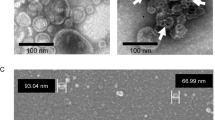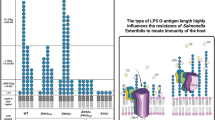Abstract
Mutations that shorten the lipopolysaccharide (LPS) in Escherichia coli were found to significantly increase the number of transformants after electroporation. The loss of the LPS outer core increased the number of transformants with plasmid pAmCyan (3.3 kb) from 5.0 × 105 colony-forming units (CFU)/μg in the wild-type E. coli BW25113 to 3.3 × 107 CFU/μg in a ΔwaaG background, a 66.2-fold increase in efficiency. Truncation of the inner core improved this even further, with the ΔwaaF mutant exhibiting the best transformation efficiencies obtained, i.e., a 454.7-fold increase in the number of colonies over the wild-type strain. Similar results were obtained when a larger plasmid (pDA1; 11.3 kb) was used, with the ΔwaaF mutant once more giving the best transformation rates, i.e., a 73.7-fold increase. Subsequent tests proved that the enhanced transformabilities of these mutants were not due to a better survival or their surface charge properties, nor from preferential binding of these strains to the plasmid. Using N-phenyl-1-naphthylamine (NPN), we confirmed that the outer membranes of these mutant strains were more permeable. We also found that they leaked more ATP (3.4- and 2.0-fold higher for the ΔwaaF and ΔwaaG mutants, respectively, than wild-type E. coli BW25113), suggesting that the inner membrane stability is also reduced, helping to explain how the DNA enters these cells more easily.
Key points
• LPS inner core gene knockouts increase the electrocompetence of E. coli.
• No significant difference in survival, surface charge, or DNA binding was evident.
• The LPS inner core mutants, however, exhibited higher outer membrane permeability.
• Their inner membranes were also leaky, based on supernatant ATP concentrations.


Similar content being viewed by others
References
Baba T, Ara T, Hasegawa M, Takai Y, Okumura Y, Baba M, Datsenko KA, Tomita M, Wanner BL, Mori H (2006) Construction of Escherichia coli K-12 in-frame, single-gene knockout mutants: the Keio collection. Mol Syst Biol 2(2006):0008. https://doi.org/10.1038/msb4100050
Barua S, Yamashino T, Hasegawa T, Yokoyama K, Torii K, Ohta M (2002) Involvement of surface polysaccharides in the organic acid resistance of Shiga Toxin-producing Escherichia coli O157:H7. Mol Microbiol 43(3):629–640. https://doi.org/10.1046/j.1365-2958.2002.02768.x
Browning DF, Wells TJ, Franca FL, Morris FC, Sevastsyanovich YR, Bryant JA, Johnson MD, Lund PA, Cunningham AF, Hobman JL, May RC, Webber MA, Henderson IR (2013) Laboratory adapted Escherichia coli K-12 becomes a pathogen of Caenorhabditis elegans upon restoration of O antigen biosynthesis. Mol Microbiol 87(5):939–950. https://doi.org/10.1111/mmi.12144
Ceremonie H, Buret F, Simonet P, Vogel TM (2004) Isolation of lightning-competent soil bacteria. Appl Environ Microb 70(10):6342–6346. https://doi.org/10.1128/Aem.70.10.6342-6346.2004
Chang V, Chen L-Y, Wang A, Yuan X (2010) The effect of lipopolysaccharide core structure defects on transformation efficiency in isogenic Escherichia coli BW25113 rfaG, rfaP, and rfaC mutants. J Exp Microbiol Immunol 14:101–107
Deditius JA, Felgner S, Sporing I, Kuhne C, Frahm M, Rohde M, Weiss S, Erhardt M (2015) Characterization of novel factors involved in swimming and swarming motility in Salmonella enterica Serovar Typhimurium. PLoS One 10(8):e0135351. https://doi.org/10.1371/journal.pone.0135351
deKievit TR, Lam JS (1997) Isolation and characterization of two genes, waaC (rfaC) and waaF (rfaF), involved in Pseudomonas aeruginosa serotype O5 inner-core biosynthesis. J Bacteriol 179(11):3451–3457. https://doi.org/10.1128/jb.179.11.3451-3457.1997
Demaneche S, Bertolla F, Buret F, Nalin R, Sailland A, Auriol P, Vogel TM, Simonet P (2001) Laboratory-scale evidence for lightning-mediated gene transfer in soil. Appl Environ Microbiol 67(8):3440–3444. https://doi.org/10.1128/AEM.67.8.3440-3444.2001
Ebbensgaard A, Mordhorst H, Aarestrup FM, Hansen EB (2018) The role of outer membrane proteins and lipopolysaccharides for the sensitivity of Escherichia coli antimicrobial peptides. Front Microbiol 9. https://doi.org/10.3389/fmicb.2018.02153
Genevaux P, Bauda P, DuBow MS, Oudega B (1999) Identification of Tn10 insertions in the rfaG, rfaP, and galU genes involved in lipopolysaccharide core biosynthesis that affect Escherichia coli adhesion. Arch Microbiol 172(1):1–8. https://doi.org/10.1007/s002030050732
Golberg A, Rae CS, Rubinsky B (2012) Listeria monocytogenes cell wall constituents exert a charge effect on electroporation threshold. Biochim Biophys Acta 1818(3):689–694. https://doi.org/10.1016/j.bbamem.2011.11.003
Guan M, Fang WD, Ullah S, Zhang XW, Saquib Q, Al-Khedhairy AA (2018) Functional genomics assessment of narcotic and specific acting chemical pollutants using E. coli. Environ Pollut 232:146–153. https://doi.org/10.1016/j.envpol.2017.09.027
Heinrichs DE, Yethon JA, Whitfield C (1998) Molecular basis for structural diversity in the core regions of the lipopolysaccharides of Escherichia coli and Salmonella enterica. Molecular Microbiology 30(2):221–232. https://doi.org/10.1046/j.1365-2958.1998.01063.x
Hirai K, Aoyama H, Irikura T, Iyobe S, Mitsuhashi S (1986) Differences in susceptibility to quinolones of outer-membrane mutants of Salmonella typhimurium and Escherichia coli. Antimicrob Agents Ch 29(3):535–538. https://doi.org/10.1128/Aac.29.3.535
Karp PD, Riley M, Saier M, Paulsen IT, Collado-Vides J, Paley SM, Pellegrini-Toole A, Bonavides C, Gama-Castro S (2002) The EcoCyc database. Nucleic Acids Res 30(1):56–58. https://doi.org/10.1093/nar/30.1.56
Keseler IM, Mackie A, Santos-Zavaleta A, Billington R, Bonavides-Martinez C, Caspi R, Fulcher C, Gama-Castro S, Kothari A, Krummenacker M, Latendresse M, Muniz-Rascado L, Ong Q, Paley S, Peralta-Gil M, Subhraveti P, Velazquez-Ramirez DA, Weaver D, Collado-Vides J, Paulsen I, Karp PD (2017) The EcoCyc database: reflecting new knowledge about Escherichia coli K-12. Nucleic Acids Res 45(D1):D543–D550. https://doi.org/10.1093/nar/gkw1003
Lin LJR, Liao CC, Chen YR, Chak KF (2009) Induction of membrane permeability in Escherichia coli mediated by lysis protein of the ColE7 operon. FEMS Microbiol Lett 298(1):85–92. https://doi.org/10.1111/j.1574-6968.2009.01705.x
Liu D, Reeves PR (1994) Escherichia coli K12 regains its O antigen. Microbiology 140(Pt 1):49–57. https://doi.org/10.1099/13500872-140-1-49
Muheim C, Gotzke H, Eriksson AU, Lindberg S, Lauritsen I, Norholm MHH, Daley DO (2017) Increasing the permeability of Escherichia coli using MAC13243. Sci Rep-Uk 7. https://doi.org/10.1038/s41598-017-17772-6
Nakao R, Ramstedt M, Wai SN, Uhlin BE (2012) Enhanced biofilm formation by Escherichia coli LPS mutants defective in Hep biosynthesis. PLoS One 7(12):e51241. https://doi.org/10.1371/journal.pone.0051241
Nikaido H (2003) Molecular basis of bacterial outer membrane permeability revisited. Microbiol Mol Biol R 67(4):593–656. https://doi.org/10.1128/Mmbr.67.4.593-656.2003
Pagnout C, Sohm B, Razafitianamaharavo A, Caillet C, Offroy M, Leduc M, Gendre H, Jomini S, Beaussart A, Bauda P, Duval JFL (2019) Pleiotropic effects of rfa-gene mutations on Escherichia coli envelope properties. Sci Rep-Uk 9:9696. https://doi.org/10.1038/s41598-019-46100-3
Parker CT, Kloser AW, Schnaitman CA, Stein MA, Gottesman S, Gibson BW (1992) Role of the rfaG and rfaP genes in determining the lipopolysaccharide core structure and cell surface properties of Escherichia coli K-12. J Bacteriol 174(8):2525–2538. https://doi.org/10.1128/jb.174.8.2525-2538.1992
Piggot TJ, Holdbrook DA, Khalid S (2011) Electroporation of the E. coli and S. aureus membranes: molecular dynamics simulations of complex bacterial membranes. J Phys Chem B 115(45):13381–13388. https://doi.org/10.1021/jp207013v
Pradel E, Parker CT, Schnaitman CA (1992) Structures of the rfaB, rfaI, rfaJ, and rfaS genes of Escherichia coli K-12 and their roles in assembly of the lipopolysaccharide core. J Bacteriol 174(14):4736–4745. https://doi.org/10.1128/Jb.174.14.4736-4745.1992
Raetz CR, Whitfield C (2002) Lipopolysaccharide endotoxins. Annu Rev Biochem 71:635–700. https://doi.org/10.1146/annurev.biochem.71.110601.135414
Schnaitman CA, Klena JD (1993) Genetics of lipopolysaccharide biosynthesis in enteric bacteria. Microbiol Rev 57(3):655–682
Teissie J, Tsong TY (1981) Electric-field induced transient pores in phospholipid-bilayer vesicles. Biochemistry-Us 20(6):1548–1554. https://doi.org/10.1021/bi00509a022
Tieleman DP (2004) The molecular basis of electroporation. Biophys J 86(1):371a–372a
Tsong TY (1991) Electroporation of cell-membranes. Biophys J 60(2):297–306. https://doi.org/10.1016/S0006-3495(91)82054-9
Vaara M (1992) Agents that increase the permeability of the outer-membrane. Microbiol Rev 56(3):395–411. https://doi.org/10.1128/Mmbr.56.3.395-411.1992
Vaara M (1993a) Antibiotic-supersusceptible mutants of Escherichia coli and Salmonella typhimurium. Antimicrob Agents Ch 37(11):2255–2260. https://doi.org/10.1128/Aac.37.11.2255
Vaara M (1993b) Outer-membrane permeability barrier to azithromycin, clarithromycin, and roxithromycin in gram-negative enteric bacteria. Antimicrob Agents Ch 37(2):354–356. https://doi.org/10.1128/Aac.37.2.354
Valvano MA, Marolda CL, Bittner M, Glaskin-Clay M, Simon TL, Klena JD (2000) The rfaE gene from Escherichia coli encodes a bifunctional protein involved in biosynthesis of the lipopolysaccharide core precursor ADP-L-glycero-D-manno-heptose. J Bacteriol 182(2):488–497. https://doi.org/10.1128/jb.182.2.488-497.2000
Weaver JC, Chizmadzhev YA (1996) Theory of electroporation: a review. Bioelectroch Bioener 41(2):135–160. https://doi.org/10.1016/S0302-4598(96)05062-3
Yamamoto N, Nakahigashi K, Nakamichi T, Yoshino M, Takai Y, Touda Y, Furubayashi A, Kinjyo S, Dose H, Hasegawa M, Datsenko KA, Nakayashiki T, Tomita M, Wanner BL, Mori H (2009) Update on the Keio collection of Escherichia coli single-gene deletion mutants. Mol Syst Biol 5:335. https://doi.org/10.1038/msb.2009.92
Yethon JA, Vinogradov E, Perry MB, Whitfield C (2000) Mutation of the lipopolysaccharide core glycosyltransferase encoded by waaG destabilizes the outer membrane of Escherichia coli by interfering with core phosphorylation. J Bacteriol 182(19):5620–5623. https://doi.org/10.1128/jb.182.19.5620-5623.2000
Funding
The funding for this project was sponsored by the National Research Foundation of Korea under the Mid-Career Project (Grant No. 2020R1A2C2012158). We appreciate the support.
Author information
Authors and Affiliations
Contributions
RJM conceived the idea; SMS and HJ conducted the experiments; SMS and RJM analyzed the data; SMS and RJM prepared the manuscript.
Corresponding author
Ethics declarations
Conflict of interest
All authors declare no conflict of interests exists with the publication of this manuscript or its data.
Ethical statement
This article does not contain any studies with human participants or animals performed by any of the authors.
Additional information
Publisher’s note
Springer Nature remains neutral with regard to jurisdictional claims in published maps and institutional affiliations.
Electronic supplementary material
ESM 1
(PDF 284 kb)
Rights and permissions
About this article
Cite this article
Soh, S.M., Jang, H. & Mitchell, R.J. Loss of the lipopolysaccharide (LPS) inner core increases the electrocompetence of Escherichia coli. Appl Microbiol Biotechnol 104, 7427–7435 (2020). https://doi.org/10.1007/s00253-020-10779-6
Received:
Revised:
Accepted:
Published:
Issue Date:
DOI: https://doi.org/10.1007/s00253-020-10779-6




